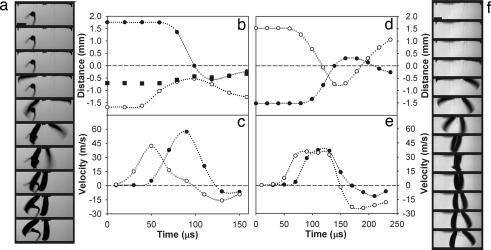Fig. 2.
The high-speed kinematics of trap-jaw strikes. (a) High-speed video images show a typical strike when an object is between the mandibles (20 μs between each frame). (b) The first mandible to move in a (open circles) strikes an object (filled squares, scaled to size) and pushes it toward the second mandible (filled circles). Zero represents the midline of the ant. (c) The second mandible to fire (a and b) (filled circles) attains a higher velocity than the first mandible (open circles). Movement opposite to the original direction of the strike is represented as negative velocity. (d) Corresponding to the images of an unobstructed strike (f), the first mandible to fire (open circles) scissors past the second (filled circles) as they cross the midline (at zero). (e) Corresponding to f, the second mandible to fire achieves a slightly higher velocity. (f) High-speed images show an unobstructed strike (20 μs between each frame). (Scale bars: 0.5 mm.) See Movie 1, which is published as supporting information on the PNAS web site.

